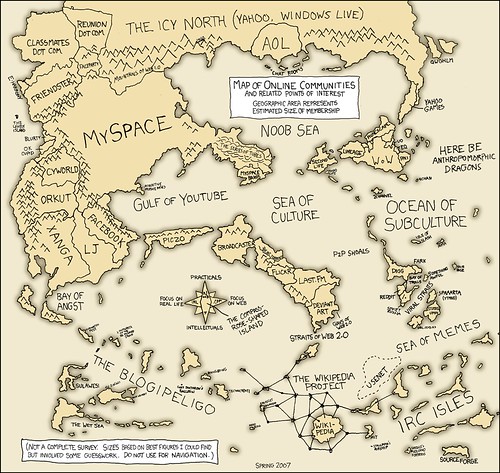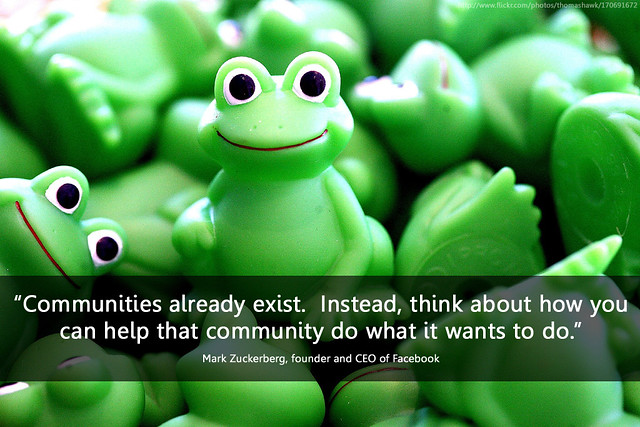We live in a time where innovation and developments in technology are radically changing the way we connect, both online and offline. The rules that define the way in which we are creating, building and participating in online communities are being drastically rewritten.
So here’s a ‘how to’ guide for building your own online community in our age of network abundance.
The first step: Learn the difference between audience and community. An audience is one-way, with few opportunities for participation. It’s a passive system based on exposure to information without much else. Community is all about an immersive, two-way, dynamic conversation where interaction is prized above all. A good community builder will know that you have to talk with, not at, your community.
Secondly, it all starts with great content. The online ecosystem affords us the opportunity to share information and knowledge with thousands of people across the globe. So create content that is educational, inspiring and/or entertaining. Design your content to be easily sharable and attention-grabbing. Ensure it is relevant, and valuable.
Weave your own unique voice + personality into your content so that your community can experience authentic, human connection. After all, that’s what it’s all about. Use well-placed humour. Add critique and analysis to ongoing discussions. Be active. Ask questions, answer questions. But keep your content true to you.

Image via flickr user .mw under CC licence BY-NC-ND 2.0
Embrace multimedia and test new ways of interaction. Social networking platforms are constantly evolving, with new models appearing all the time. Stay agile: mix your mediums and experiment. Find what feels right for you and your community. Take chances. Reward your risks. Just remember that consistency is key – keep the momentum going by developing a regular posting schedule.
Think of your community members as advocates, rather than numbers. The size of your community is not the defining factor or metric of success: it’s about depth and quality of engagement. Each individual in your community offers a unique occasion for your brand to spread further into new networks.
Go global. Try not to marginalise your content by making it too geographically specific. Send out your feelers all over the world and see how far you can reach. Just remember to track your outputs. Your data will reveal patterns and tell you stories, so make sure you are listening.
Think about whether you want to be a community creator or a community facilitator. If the community you want to create already exists, you’re too late to the party. Either change tact, or jump on board to help the existing movement get to a better place. Positively participate and add value without trying to reinvent the wheel. Most importantly, don’t try to piggyback your way through by merely associating with an established community. Make your impact felt, and use your influence for good.

Image via flickr user Will Lion under CC license BY-NC-ND 2.0
Realise that your online community has got to spread offline at some point. So create and leverage events which allow individuals to meet and network with each other face-to-face. There are some incredibly exciting opportunities for this kind of community-building, such as the British organisation Hiive, which is a networking site for the creative industries where you can join ‘swarms’ of people who share your interests and skill sets. David Garland, a self-confessed ‘mediapreneur’, says:
While a virtual handshake is amazing, nothing quite replaces a real life one”
Provide opportunities for your community members to feel empowered and legitimised. Direct interaction is an excellent example of this, and this is often found in the comments section of blogs and social media posts. Take time to get to know your users, and if there is a particularly engaged member, offer them a chance to participate directly (such as in a guest blog post or similar). User generated content is an amazing bridge between an organisation and a community.
Don’t try to own or control your community. Realise that they have as much agency as you do. On each end of the screen, you are both humans. Communities with this kind of ‘flat’ structure and lack of hierarchy are the ones which blossom the most. They enable relationships of trust and meaningful interactions. As British YouTuber Dodie Clark says:
Treat your followers as your friends, and hopefully they’ll do the same to you.”
Online Communities: Just Regular People Behind Those Pixels http://t.co/TaMTcUFRf9 #cmgr pic.twitter.com/sFWgEPSDiT
— Treble.io (@treble_io) October 16, 2014
